Granada - Spain
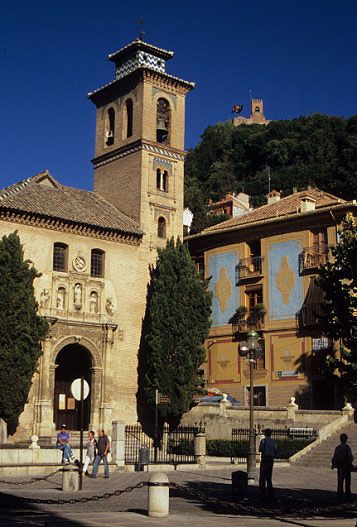
Iglesia de Santa Ana y San Gil in Granada
1492 was quite a year for the catholic monarchs Ferdinand of Aragon and Isabella of Castile. Their most famous accomplishment was to send Christopher Columbus on his way to the New World. Less well known is that Ferdinand and Isabella also defeated the Moors in that year, capturing Granada which for centuries had been the last Moorish stronghold in Spain. Ferdinand and Isabella are interred in the Royal Chapel, one of a number of Catholic buildings in Granada that tourists should see.
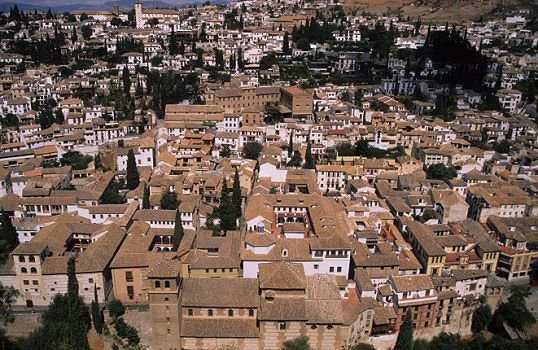
View of the Albaicin district.
Construction of Granada Cathedral began on the site of the Central Mosque in 1518. A Gothic building similar to the cathedral in Toledo was planned, but after 10 years the man in charge, Enrique Egas, was replaced by Diego Siloe, who decided that a Renaissance style would be better. Finished around two hundred years later, the world was given a remarkable site. Five aisles lead to a semi-circular ambulatory, the central element of which is a high central altar. The vaulting overhead is Gothic. Attached to the Cathedral, but not accessible from it, is the Royal Chapel built between 1506 and 1521 by Enrique Egas. Entrance is via a Plateresque building called La Lonja, the city’s former exchange. (Plateresque is a style that resembles a silversmith’s work).
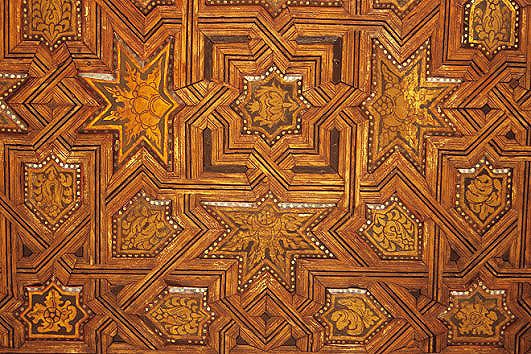
Alhambra - Marquetry at the Patio de los Leones
Having walked through the graceful columns and arches of La Lonja, there are two things that should not be missed in the single nave chapel. The first is the 16th-century screen by Master Bartolome of Jaen that encloses the chancel. The upper section shows scenes from the life of Christ. The yoke and arrow symbols below depict King Ferdinand and Queen Isabella. The second attraction is down a set of steps (strictly one way). The Mausoleums are carved out of Carrera marble and decorated with religious scenes. On one side are the tombs of the monarchs and on the other, those of their daughter, the charmingly named Joan the Mad and her husband, Philip the Handsome. All the coffins are surprisingly plain given the king and queen’s achievement in uniting Aragon and Castile, an alliance that formed the basis for today’s Kingdom of Spain.
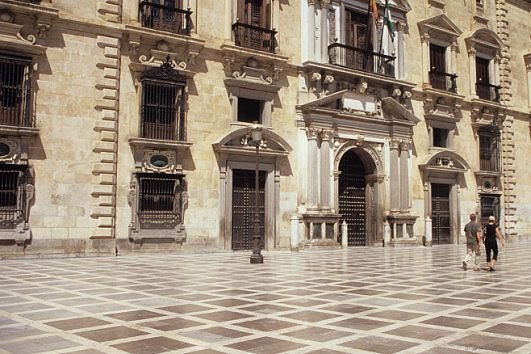
Granada - Chancilleria
All the while I was there, the soundtrack from the film 1492: Conquest of Paradise by Vangelis was playing in the background. As if to confirm this conquest theme, King Ferdinand’s sword and Queen Isabella’s sceptre and crown are just three of the priceless items kept in the museum. There are many religious paintings by esteemed painters such as Botticelli, Memling, and Rogier van der Weyden.
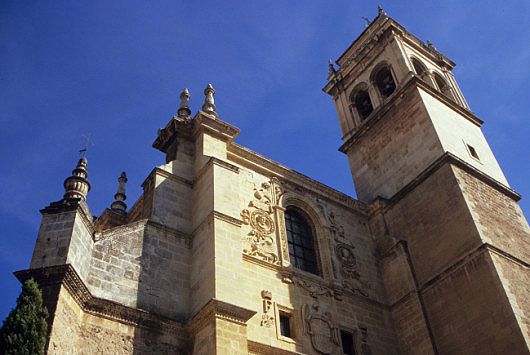
Granada - Church at the Monasterio de San Jeronimo
Heading North-West from the cathedral, along San Jeronimo street, the visitor passes on their left the law faculty of the university dating from the 18th Century. At the end of this street is the 300-year old Baroque Iglesia de San Juan de Dios. Nearby is the Monastery of San Jeronimo, started just four years after the Moors left. The upper façade of the monastery’s church contains the coats of arms of the Catholic Monarchs.
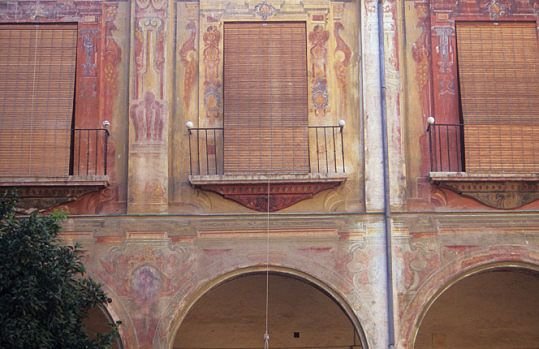
Granada - Courtyard at the hospital at San Juan de Dios basilica
Heading back towards the cathedral, the area towards the south-west is known as La Alcaiceria and was the Moorish silk-market. Today, some of the narrow streets are reminiscent of Morocco, and the souvenirs are of mainly North African origin, along with other pieces from India. There are many similar shops in the El Albaicin district, located on a hill facing the Alhambra. This was the area where the Moorish king lived in the 11th century. Dating from this time are the city walls, arches such as the Arco de las Pesas, and the baths El Banuelo.
In El Albaicin, several churches were built over mosques and other Moorish structures and the remains can still be seen today. In the Iglesia del Salvador are the foundations of Granada's Great Mosque, Santa Isabela la Real contains traces of a palace, and under the Convent of Santa Catalina are stones from an 11th-Century house. Builders of Christian churches weren’t immune from Moorish influences. On the small plaza de Santa Ana lies the small 16th-century church of Santa Ana y San Gil. Its bell tower has azulejo tile decorations and the nave ceilings are Mudejar in style. Also in the Albaicin district is the Iglesia de San Jose, which incorporates a 10th-century minaret as a bell tower.
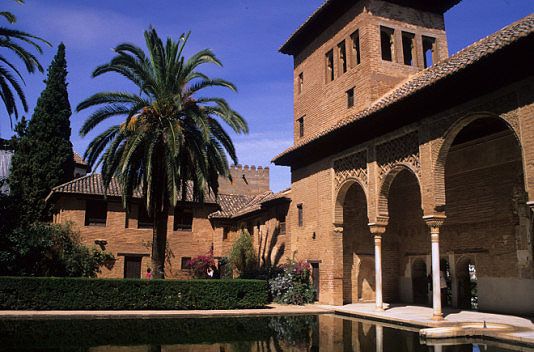
Alhambra - Jardines del Partal
Of course any trip to Granada must include a visit to the Alhambra – “the red one” - a fortress dating from the time of the Nasrids, the last Islamic dynasty to rule Spain. The Alhambra contains both the Nasrid’s palace and that of Emperor Charles V, built in the 1500s. The contrast between the two couldn’t be starker - Charles’s palace is imposing, plain, and devoid of character. The Nasrid palace is full of marquetry, delicate stone carvings, and intricate tilework. There is also the Lion’s Courtyard, named from the 12 lions that support the thousand-year old fountain at its centre. For me the most beautiful place is the Jardines del Partal, the Partal Gardens. The Moorish architecture and palm trees are beautifully mirrored in a large reflecting pool and from the terrace there are views over El Albaicin. The terraced Generalife Gardens are next to the Alhambra. The central Patio de la Acequia is lined with water jets and some of the staircases, most famously the Escalera de Agua, have open channels that form part of a mini-irrigation system.
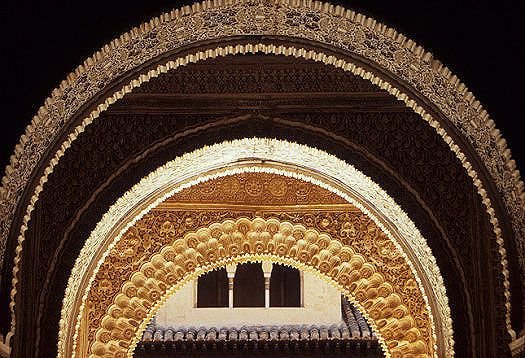
Alhambra - Arches at the Patio de los Leones
By the use of terracing and irrigation the Moors transformed some of the valleys in the nearby Sierra Nevada mountains into some of the most fertile in the whole of Spain. They moved to this region, now known as Las Alpujarras, in 1492 and the abundant supply of grapes, oranges, figs, and bananas must have eased the pain the Moors felt at having to leave their beloved Granada.

Alhambra - Intricate stone carving at the Patio de los Leones
Congratulations @julianworker! You have completed some achievement on Steemit and have been rewarded with new badge(s) :
Click on any badge to view your Board of Honor.
For more information about SteemitBoard, click here
If you no longer want to receive notifications, reply to this comment with the word
STOP